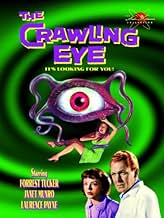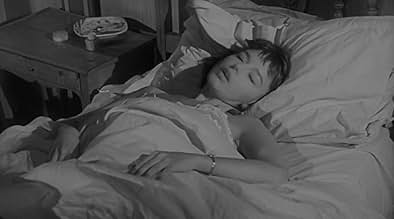IMDb-BEWERTUNG
5,2/10
5101
IHRE BEWERTUNG
Füge eine Handlung in deiner Sprache hinzuA series of decapitations on a Swiss mountainside appear to be connected to a mysterious radioactive cloud.A series of decapitations on a Swiss mountainside appear to be connected to a mysterious radioactive cloud.A series of decapitations on a Swiss mountainside appear to be connected to a mysterious radioactive cloud.
Handlung
WUSSTEST DU SCHON:
- WissenswertesJohn Carpenter has said that this film, with its creatures hidden in the clouds, was partly the inspiration for his film The Fog: Nebel des Grauens (1980).
- PatzerAfter Brett gashes his forehead in a fight, they discover he does not bleed and that he is already dead. Yet Professor Crevette gives Brett an inject-able sedative in the arm. No blood means there is no way for the drug to travel to his brain.
- Zitate
Sarah Pilgrim: *Was* there an accident, Mister Klein?
Mayor Klein: O-On a mountain, uh, dese things sometimes happen.
- Crazy CreditsThe film's opening credits flash onto the screen when the passenger train rolls into the darkness of a tunnel.
- VerbindungenEdited into FrightMare Theater: The Crawling Eye (2017)
Ausgewählte Rezension
A series of decapitations on a Swiss mountainside appear to be connected to a mysterious radioactive cloud, not unlike one that appeared in the Andes years earlier.
Although one of the earliest films to be lampooned on "Mystery Science Theater 3000", there is no denying the growing reputation this movie has received over the years: not only was it referenced in Stephen King's "It", but was also the primary influence behind John Carpenter's minimalist masterpiece "The Fog" (which itself has gone on to influence others).
"Crawling Eye" was the debut feature for director Quentin Lawrence, and probably remains his best-known work. Writer Jimmy Sangster (adapting the work of Peter Key) had only been working a few years, but was a rising star with such Hammer classics as "Dracula" and "Curse of Frankenstein" under his belt. Here he crafts a tale of science gone wrong mixed with the living dead, and done to perfection.
Most interestingly, shortly before the film was released, Lawrence directed a 6-part television miniseries with Key writing the episodes. Today, no copies are thought to exist, and there is no way to know what changes were made for the big screen, as well as what cuts had to be administered to accommodate the shorter running time.
Leading the cast is Forrest Tucker as United Nations troubleshooter Alan Brooks. Tucker had been in nearly 100 films during the 1940s and 50s, and easily handles his role here as the hero -- part action star, part scientific genius. He is assisted by Warren Mitchell as a caricatured Swiss professor (a portrayal which provides the film's only comic relief).
The standout performance comes from Janet Munro as a semi-psychic young woman who goes into trances when she nears the cloud. One gets the impression that she had a bright career before her, and indeed was given a Golden Globe in 1960. Sadly, she passed unexpectedly at age 38.
Today's audiences might find some of the special effects cheesy. Obviously the crew used miniature sets and plenty of rear projection. But in general, there is no denying the impressive use of fog, the freezing effects and the creepy realism of the titular eye. While other 1950s films were busy using radiation as a plot device for large bugs, this one went in a completely different direction -- possibly the only film of its kind.
Notably, "Crawling Eye" was the final film to be produced by Southall Studios, one of the earliest pioneer film studios in the UK, which had made a steady stream of films since 1924. They went out on a high note, which is always nice.
Although one of the earliest films to be lampooned on "Mystery Science Theater 3000", there is no denying the growing reputation this movie has received over the years: not only was it referenced in Stephen King's "It", but was also the primary influence behind John Carpenter's minimalist masterpiece "The Fog" (which itself has gone on to influence others).
"Crawling Eye" was the debut feature for director Quentin Lawrence, and probably remains his best-known work. Writer Jimmy Sangster (adapting the work of Peter Key) had only been working a few years, but was a rising star with such Hammer classics as "Dracula" and "Curse of Frankenstein" under his belt. Here he crafts a tale of science gone wrong mixed with the living dead, and done to perfection.
Most interestingly, shortly before the film was released, Lawrence directed a 6-part television miniseries with Key writing the episodes. Today, no copies are thought to exist, and there is no way to know what changes were made for the big screen, as well as what cuts had to be administered to accommodate the shorter running time.
Leading the cast is Forrest Tucker as United Nations troubleshooter Alan Brooks. Tucker had been in nearly 100 films during the 1940s and 50s, and easily handles his role here as the hero -- part action star, part scientific genius. He is assisted by Warren Mitchell as a caricatured Swiss professor (a portrayal which provides the film's only comic relief).
The standout performance comes from Janet Munro as a semi-psychic young woman who goes into trances when she nears the cloud. One gets the impression that she had a bright career before her, and indeed was given a Golden Globe in 1960. Sadly, she passed unexpectedly at age 38.
Today's audiences might find some of the special effects cheesy. Obviously the crew used miniature sets and plenty of rear projection. But in general, there is no denying the impressive use of fog, the freezing effects and the creepy realism of the titular eye. While other 1950s films were busy using radiation as a plot device for large bugs, this one went in a completely different direction -- possibly the only film of its kind.
Notably, "Crawling Eye" was the final film to be produced by Southall Studios, one of the earliest pioneer film studios in the UK, which had made a steady stream of films since 1924. They went out on a high note, which is always nice.
Top-Auswahl
Melde dich zum Bewerten an und greife auf die Watchlist für personalisierte Empfehlungen zu.
- How long is The Crawling Eye?Powered by Alexa
Details
- Erscheinungsdatum
- Herkunftsland
- Sprachen
- Auch bekannt als
- The Crawling Eye
- Drehorte
- Alliance Film Studios, St Margarets, Twickenham, Middlesex, England, Vereinigtes Königreich(studio: made at Alliance Film Studios Ltd)
- Produktionsfirma
- Weitere beteiligte Unternehmen bei IMDbPro anzeigen
- Laufzeit1 Stunde 22 Minuten
- Farbe
- Seitenverhältnis
- 1.66 : 1
Zu dieser Seite beitragen
Bearbeitung vorschlagen oder fehlenden Inhalt hinzufügen

Oberste Lücke
What is the Spanish language plot outline for Die Teufelswolke von Monteville (1958)?
Antwort


























